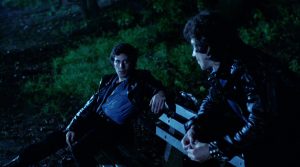IN THE annals of film controversy William Friedkin’s Cruising is right up there.
Released in 1980, it stars Al Pacino as a police officer who goes undercover within New York sado-masochistic community to track down a serial killer preying on gay men.
The film was based on a magazine article about a series of actual unsolved killings that had occurred in the same community in the early 1970s.
The renowned maverick film-maker Friedkin, riding high on critical opinion after the success of The French Connection and The Exorcist, agreed to do the film after initially rejecting approaches. Exterior filming was dogged from the start by gay rights protesters who caused constant disruptions with horns and mirrors, convinced the film would portray the wider gay community negatively through association.
Friedkin’s problems continued with a protracted battle with both the censors and the film’s distributors over his determination to include what even today could be considered strong sex scenes designed to achieve the necessary authenticity to the story.
ON its release many critics also railed against the film, both for its approach to the material and a deliberately ambiguous ending that left many audiences also baffled and annoyed.
Today, with the passage of time, Cruising is more recognised as another thoroughly impressive piece of 1980s experimental work by an uncompromising and visionary director who brought helped bring European guerrilla film-making tactics to the streets of America.
There are several faults with the film, in particular a lack of continuity between some scenes and the at times frustratingly puzzling script, particularly in the scenes between Pacino’s character and his girlfriend, but there is no denying the power and kinetic energy that Friedkin and his star bring to the screen.
In 1980 Cruising was a big deal; no mainstream film had ever tried to set a thriller within such a sexually explicit framework, let alone gone into the leather clubs operating at the time to film activities as they were occurring.
Friedkin was eventually forced by the censors to cut 40 minutes from his original version, film that has allegedly since been ‘lost’ by the responsible studio which means we will never know whether it may have enhanced audience understanding of the final result.
Pacino was on a career high due to The Godfather I and II and Dog Day Afternoon when he chose to make And Justice For All followed by Cruising and then Scarface. All three films weren’t well received at the time of their releases but have gone on to become much better regarded by critics and audiences.
Friedkin’s vision and the script for Cruising gave Pacino an almost impossible task to make audiences either empathise or even understand the mind and motivations of young undercover cop Steve Burns and his S&M alter-ego John Forbes, but remarkably Pacino managed to achieve just that.
Paul Sorvino is good as Burns’ detective handler in his key scenes but Karen Allen as Burns’ girlfriend is figuratively thrown under a bus by Friedkin and her scenes with Pacino are among the film’s weakest and most frustrating.
In different interviews Friedkin has either said the missing 40 minutes added important depth to the story and Pacino’s character and were vitally important or has said they were just more scenes of graphic sex filmed in the clubs that didn’t add anything.
The history of this flawed, frustrating and sometimes brilliant film will never be successfully concluded.
